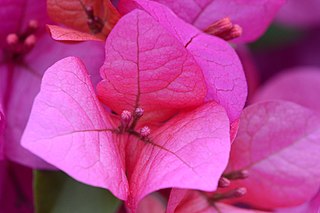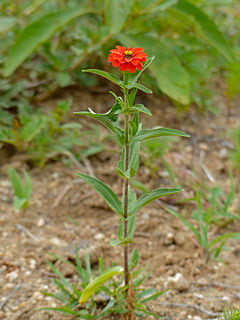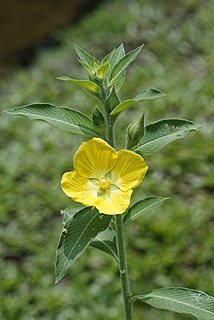
Apocynaceae is a family of flowering plants that includes trees, shrubs, herbs, stem succulents, and vines, commonly known as the dogbane family, because some taxa were used as dog poison. Members of the family are native to the European, Asian, African, Australian, and American tropics or subtropics, with some temperate members. The former family Asclepiadaceae is considered a subfamily of Apocynaceae and contains 348 genera. A list of Apocynaceae genera may be found here.

Bougainvillea is a genus of thorny ornamental vines, bushes, and trees belonging to the four o' clock family, Nyctaginaceae. It is native to eastern South America, found from Brazil, west to Peru, and south to southern Argentina. Different authors accept from 4 to 18 species in the genus. The inflorescence consists of large colourful sepal-like bracts which surround three simple waxy flowers.

Physalis peruviana, is a South American plant native to Peru and Colombia in the nightshade family (Solanaceae), commonly known as Cape gooseberry or goldenberry, known in their countries of origin as uchuva, and in Hawaii called poha, in addition to numerous indigenous and regional names. The history of P. peruviana cultivation in South America can be traced to the Inca. It has been cultivated in England since the late 18th century, and in South Africa in the Cape of Good Hope since at least the start of the 19th century. Widely introduced in the 20th century, P. peruviana is cultivated or grows wild across the world in temperate and tropical regions.

Echinopsis peruviana, the Peruvian torch cactus, is a fast-growing columnar cactus native to the western slope of the Andes in Peru, between about 2,000–3,000 m (6,600–9,800 ft) above sea level.

Guzmania is a genus of over 120 species of flowering plants in the botanical family Bromeliaceae, subfamily Tillandsioideae. They are mainly stemless, evergreen, epiphytic perennials native to Florida, the West Indies, southern Mexico, Central America, and northern and western South America. They are found at altitudes of up to 3,500 m (11,483 ft) in the Andean rainforests.

Schinopsis is a genus of South American trees in the family Anacardiaceae, also known by the common names quebracho, quebracho colorado and red quebracho. In Brazil it is known as baraúna or braúna.

Scilla peruviana, the Portuguese squill, is a species of Scilla native to the western Mediterranean region in Iberia, Italy, and northwest Africa.

Triuridaceae are a family of tropical and subtropical flowering plants, including nine genera with a total of ca 55 known species. All members lack chlorophyll and are mycoheterotrophic. The heterotrophic lifestyle of these plants has resulted in a loss of xylem vessels and stomata, and a reduction of leaves to scales.
Haplorhus is a genus of plants in the family Anacardiaceae. Haplorhus peruviana is the only species in the genus. It is found in dry ravines located in Chile and Peru.
Symplocos peruviana is a species of plant in the family Symplocaceae. It is endemic to Peru.

Xylopia is a genus of flowering plants in the family Annonaceae. They are mostly trees and some shrubs. There are about 160 species distributed in Asia, Africa, and the Americas.
Virola peruviana is a species of tree in the family Myristicaceae. It is found in Brazil, Colombia, Ecuador and Peru. It grows to a height of about 35 m (100 ft). The fruit is ellipsoidal, 14–24 mm long and 11–23 mm in diameter, forming groups of about 5 to 15.

Cascabela thevetia is a poisonous plant native throughout Mexico and in Central America, and cultivated widely as an ornamental. It is a relative of Nerium oleander, giving it a common name yellow oleander, and is also called lucky nut in the West Indies.

Duguetia is a genus of trees and shrubs in the plant family Annonaceae with approximately 90 species in central and South America, and four species in west Africa.

Zinnia peruviana, the Peruvian zinnia, is an annual flowering plant in the family Asteraceae. It is native to North America and South America.

Gratiola peruviana, commonly known as austral brooklime, is a small perennial herb in the family Plantaginaceae. The species is native to South America and Australasia. It grows to between 10 and 30 centimetres high and has pink or white tubular flowers with red-purple stripes inside. These are followed by ovoid capsules that are up to 7mm long. The stem-clasping ovate leaves are arranged in opposite pairs and have shallowly toothed edges.

Ludwigia peruviana, with the common names Peruvian primrose-willow or Peruvian water primrose, is an aquatic, sometimes deciduous species of flowering plant in the evening primrose family. It can grow to approximately 12 feet (3.7 m) in height. While native to Peru, it has been introduced in many other countries for its attractive simple yellow flowers, it is now a common weed in swampy areas around the world.
Eragrostis peruviana is a species of flowering plant in the family Poaceae, native to Peru to northern Chile, including the Desventuradas Islands. It was first described by Nikolaus Joseph von Jacquin in 1787 as Poa peruviana, and transferred to Eragrostis by Carl Bernhard von Trinius in 1830.
Stillingia peruviana is a species of flowering plant in the family Euphorbiaceae. It was described in 1951. It is native to Peru.
Plinia peruviana, commonly known as jabuticaba cabinho in Brazil, is a species of plant in the family Myrtaceae. It is endemic to central, South America.













